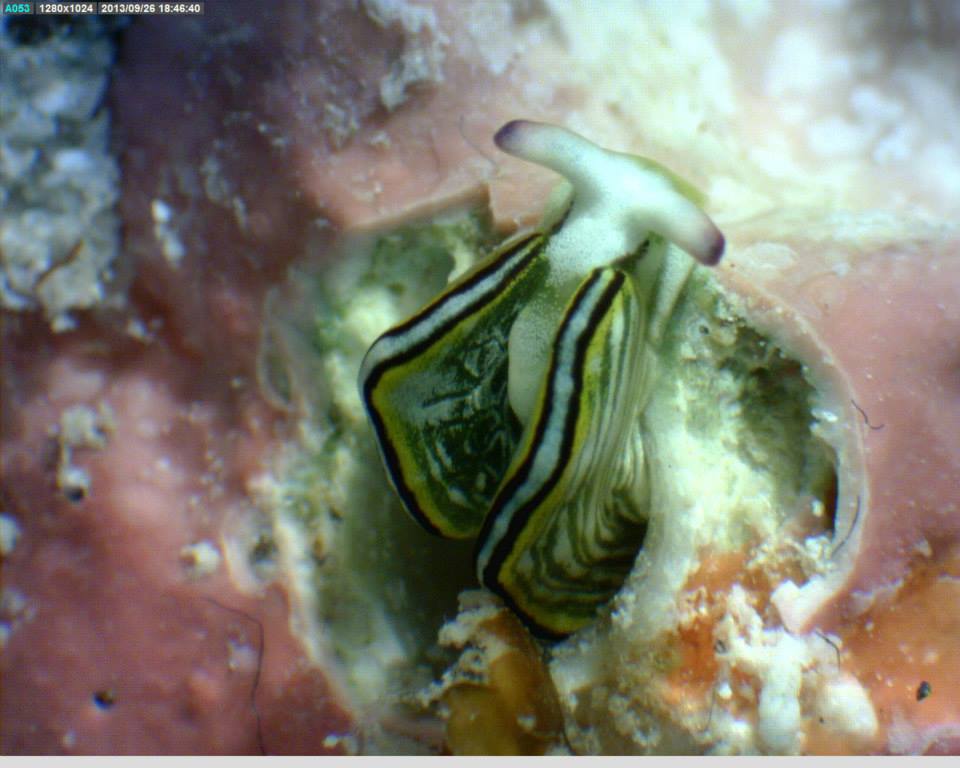Summary
Physical Description
Size and Colouration
External Anatomy
Ecology
Local Distribution and Microhabitat
Life History & Behaviour
Reproduction
Development and Locomotion
Feeding and Respiration
Behavioural Observations
Anatomy & Physiology
Internal Anatomy
Histological Sectioning
Evolution & Systematics
Phylogeny and Kleptoplasty
Biogeographic Distribution
Conservation & Threats
References & Links
Reference List
Useful Links
Glossary | Conservation & Threats
 Very little work has been undertaken to investigate the potential threats posed to members of the Elysiidae family. In 1994, Kerry Clark undertook an extensive analysis of case history data for 33 species of Sacoglossans across three families in the Florida Keys region [2]. The analysis revealed that 16 of the 34 species studied were experiencing long-term population decline, while for another 9 species long-term trends could not be determined due to rarity or difficulty accessing populations [2]. Only 9 species were seen to have stable populations [2]. It was noted that the cause of the decline was difficult to determine, though key drivers of population decline were found for some species[2]. These included siltation, eutrophication, habitat destruction and overcollection [2]. Very little work has been undertaken to investigate the potential threats posed to members of the Elysiidae family. In 1994, Kerry Clark undertook an extensive analysis of case history data for 33 species of Sacoglossans across three families in the Florida Keys region [2]. The analysis revealed that 16 of the 34 species studied were experiencing long-term population decline, while for another 9 species long-term trends could not be determined due to rarity or difficulty accessing populations [2]. Only 9 species were seen to have stable populations [2]. It was noted that the cause of the decline was difficult to determine, though key drivers of population decline were found for some species[2]. These included siltation, eutrophication, habitat destruction and overcollection [2].
Several of the Elysia species studied were experiencing population decline as a result of siltation, while others had experienced localised population extirpation as a result of shoreline disturbance or habitat destruction [2]. Sacoglossans have many life history strategies which make them predisposed to extinction from anthopogenic factors, and unshelled sacoglossans have numerous adaptations which indicate an evolutionary history of low-silt habitats [2]. Shell-less sacoglossans such as the Elysiidae have co-opted the generous dorsal surface area afforded by their wide parapodia into a respiratory organ, and their epithelium is largely covered in microvilli for nutrient uptake [2,34]. Kleptoplasty is known to be widespread amongst the sacoglossans, particularly within the Elysiidae, and requires both a large surface area for gas exchange and high light attenuation [2,35]. High-silt conditions disrupt these processes, resulting in decreased respiratory efficiency and nutrient uptake.
Most Elysia species deposit gelatinous egg masses in elevated areas where oxygen concentration is greatest [2]. The gelatinous egg masses provide a barrier to oxygen diffusion, which is known to control development rates in sacoglossans [2,36]. Increased siltation would reduce the oxygen available to the developing young and greatly impact upon development rates [2]. It has also been noted anecdotally that increased siltation results in increased bacterial and protozoan attack on these gelatinous egg masses [34].
Most sacoglossans are thought to have non-planktotrophic larvae, indicating low dispersal and a reduced ability to recolonise important habitats following a local extinction event [2]. It has also been noted that even species with planktotropic larvae appear to have low dispersal and a tendency to remain near to the parent population, suggesting that the generalisation that species with planktotrophic larvae have high dispersal may not apply to sacoglossans [2]. In addition to their low dispersal, many sacoglossans, particularly, within the Elysiidae, are specialist feeders, further increasing the likelihood of extinction, particularly localised extinctions [2]. Given this, it is likely that the greatest threat posed to Elysia sp. is siltation, particularly if Gladstone Harbour is continually dredged and developed into the future.
Several aspects of Clark's 1994 study are worth noting here. Firstly, the study determined that the habitat and feeding specificity of these sacoglossans affords them a unique position as indicators of environmental health [2,34,36]. Secondly, sacoglossans function as key 'vernier' species, controlling abundance and dominance relationships of ecologically important primary producers [2]. Lastly, these species may serve as a more accessible model for understanding extinction risks in many other rare marine invertebrate taxa [2]. Localised and global extirpations of sacoglossans is a very real threat, and could cause undesirable shifts in ecosystem structure, including system destabilisation [1]. It is of paramount importance, then, that we conserve sacoglossan species such as Elysia sp., and that this kind of information is considered in decision making and development approval into the future. |
|